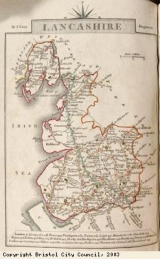Scotland, Ireland and the North
Scotland had an Africa trading company by 1695. The traders there were keen to join the profitable trade, which was controlled by London merchants. The Scottish cities of Edinburgh, Glasgow, Dundee, Inverness and Montrose all campaigned against this London control. They wanted the government to change the laws so that the London-based Royal African Company (a trading company) would lose its control over the trade to Africa. A partnership of bankers and traders fitted out a slave ship from Edinburgh in 1695. As a result of the campaign to end the Royal African Company control, other merchants were allowed to trade to Africa if they paid the Royal African Company for the privilege. The money would go towards costs, such as maintaining the slave forts on the west coast of Africa. Slave traders used the forts as a base, slaves could be kept there before their journey across the Atlantic Ocean, and slave ships could anchor nearby.
Glasgow was sending a few slaving voyages out, but the local merchants came to trade more in tobacco than in slaves. The city developed a major industry processing the slave-produced tobacco.
Newcastle, on the north east coast of England, along with nearby Hull and Yarmouth on the east coast, seem to have avoided the slave trade itself. Instead they traded directly with the plantations in America and the Caribbean. They supplied the colonies with the many items they needed, including window glass and vegetable seeds. Tobacco, sugar and rum came back from the Caribbean and were processed in the cities. This contributed to the growth in their industries.
Liverpool, on the north west coast of England, was the major slaving port in the north of England. The trade from this small port developed in the early 18th century. In the 1740s Liverpool overtook Bristol in the slave trade. The reasons for this are not clear. Liverpool may have had lower local wage rates than Bristol, which would led to higher profits for investors. The city had good port facilities and closer access to the manufacturing towns of the north and midlands than Bristol. Liverpool may have overtaken Bristol in the slave trade because its merchants were more enterprising, and more willing to take risks, than merchants elsewhere. Liverpool remained the country’s major slaving port for the rest of the century. Lancaster, also on the north west coast of England, is pictured here in 1792. The town had merchants who were involved in the slave trade. Having started slowly and gradually increasing the number of voyages, Lancaster became the fourth biggest slaving port after Liverpool, London and Bristol. Merchants and ships from other smaller ports traded through Lancaster. These included towns such as Preston on the north east coast, and the nearby towns of Poulton and Ulverston.
A merchant called Isaac Milner in the town of Whitehaven, on the north east coast of England, invested in a large number of African voyages out of Bristol and London (rather than Whitehaven itself). Others in the town invested in voyages to Africa. They also invested in voyages carrying slaves from the Caribbean island of Barbados to the southern state of Virginia in America. They brought tobacco back. Whitehaven’s isolated position meant that it soon dropped out of the long-distance trade with the Caribbean. This was because organising trade goods and finance was difficult in a town so far away from the big manufacturing towns.
Merchants from Ireland were investing in slaving voyages in the early 18th century, but it was never a major part of their trade. Irish ports like Dublin on the east coast, Belfast on the north eastern coast, Limerick in the south east and Kinsale on the south coast were involved indirectly with the trade. They were often used by English ships to supply provisions such as food and water as they set off for Africa.





